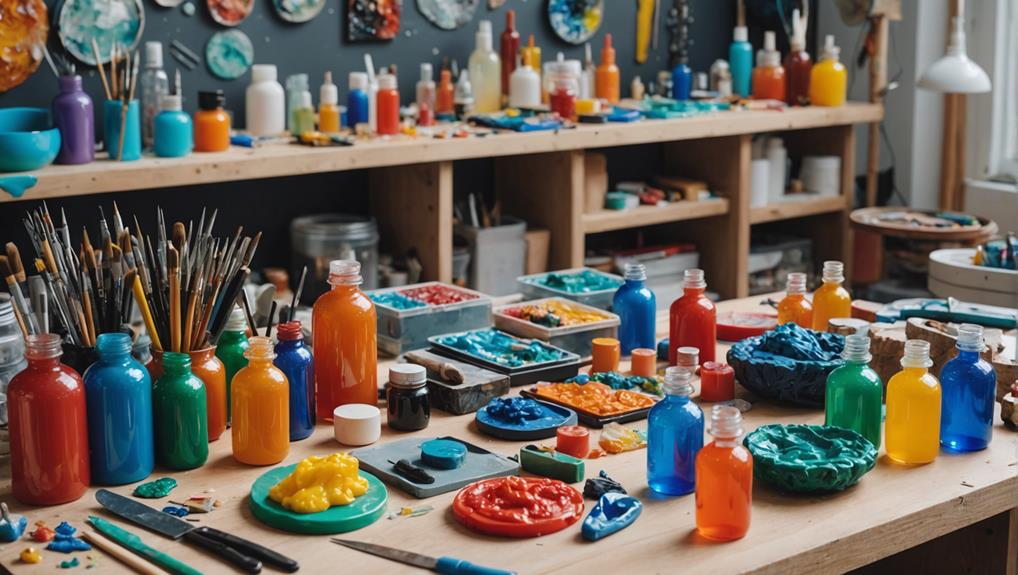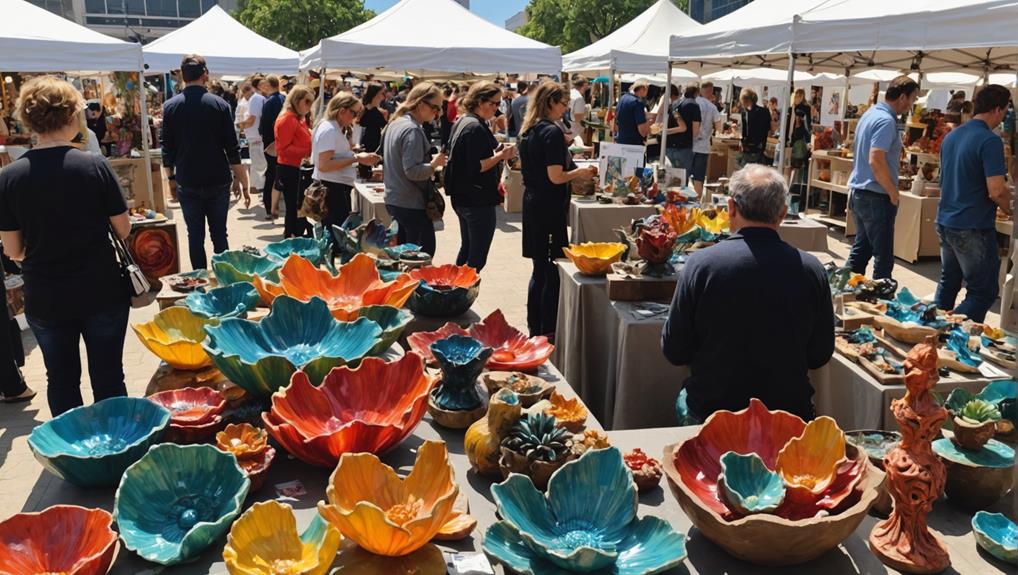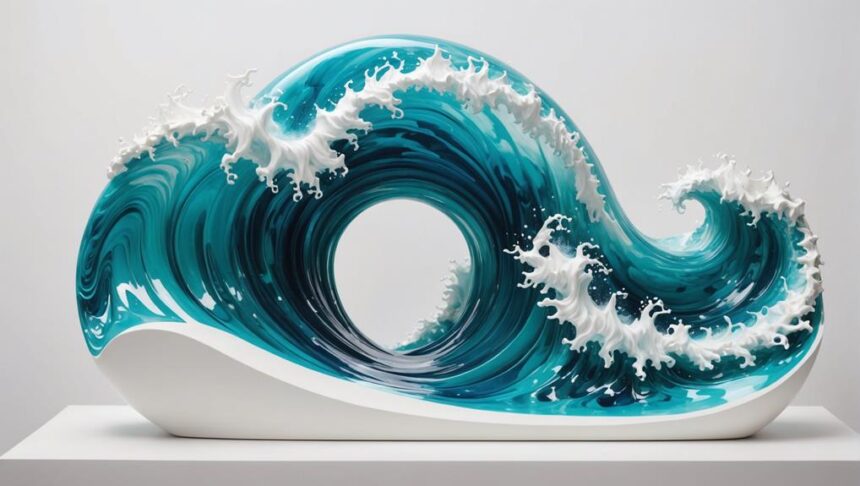Resin sculpture art involves creating cool 3D artworks using a special material called resin. This stuff is durable, lightweight, and can be molded into detailed shapes and vibrant colors. Artists love it because it can look like traditional stone or bronze but is much easier to handle. It's trending because you can make everything from fancy river tables to intricate statues that capture light in magical ways. Plus, it can be mixed with cool things like glitter or flowers to make unique pieces. Stick around to discover the magic behind those stunning resin masterpieces and why everyone's buzzing about them!
Key Takeaways
- Resin sculpture art involves creating durable, lightweight three-dimensional artworks using resin, known for its versatility and ability to mimic traditional materials.
- Epoxy resin is favored for its clarity and detail, allowing intricate designs and vibrant coloring, contributing to its popularity.
- The creation process includes crafting an original model, using flexible molds, and mixing resin with a catalyst for hardening.
- Popular trends include resin flower preservation and customized furniture like river tables, blending functionality with artistic expression.
What Is Resin Sculpture Art?
Resin sculpture art involves the creation of three-dimensional artworks using resin, a versatile material known for its durability and lightweight properties. This method has a rich history, tracing back to when artists sought more adaptable materials than traditional stone or bronze. Resin, particularly epoxy, became a favorite due to its clarity and ability to incorporate colors and even objects, enhancing the visual appeal of the sculptures.
In artist interviews, many share their love for resin, noting how it allows them to experiment and push the boundaries of their creativity. They often start with a model made from clay or wax, then create molds from silicone or rubber. This process lets them produce multiple copies of their work, making resin sculptures a fantastic choice for both amateurs and professionals.
What's really cool is how resin sculptures can vary in size—from tiny collectibles to massive installations. This flexibility means that anyone can try their hand at resin art, whether you're an established artist or just starting out. The growing popularity of resin art can be credited to its durability and customization options, making it a trendy choice in the world of contemporary art.
Characteristics of Resin Sculptures
One of the most defining characteristics of resin sculptures is their ability to mimic traditional materials like stone, porcelain, bronze, and marble while remaining lightweight and durable. This makes them a favorite among artists and collectors alike. Imagine lifting a sculpture that looks like it's carved from heavy marble, but it's as light as a feather—that's the magic of resin!
Artistic versatility is another huge plus. Resin can be molded into intricate designs, capturing even the tiniest details. Artists start with a model made from clay or wax, then create a silicone mold to get all the fine features just right. This lets them make multiple copies of the same sculpture, making it easier for collectors to snag a piece of art they love.
However, there are some durability concerns. Resin sculptures are tough, but they don't like extreme temperature changes. If it gets too cold, they might crack, which is a bummer. So, if you're a collector, keep them cozy.
Despite these concerns, the lightweight nature and artistic versatility of resin make it a trending choice for modern sculptures. Whether you're an artist or a collector, there's a lot to love about resin sculptures!
Types of Resin Used
When it comes to resin sculpture art, there are two main types of resins to evaluate: natural and synthetic.
Natural resins come from plants or insects and are eco-friendly.
On the other hand, synthetic resins like epoxy and acrylic are man-made and offer different benefits.
Epoxy resin is the superstar here—it's clear, super strong, and sticks to almost anything, making it perfect for detailed and durable sculptures.
Natural Vs. Synthetic Resins
In the domain of resin sculpture art, the choice between natural and synthetic resins greatly influences both the creative process and the environmental impact of the artwork.
Natural resins, like rosin from pine trees, are organic substances produced by plants or insects. They are biodegradable and have been used traditionally in varnishes and adhesives, offering numerous natural resin benefits such as a lower environmental footprint.
On the other hand, synthetic resin innovations have revolutionized modern art, providing materials like epoxy and acrylic that are manufactured industrially.
When deciding between natural and synthetic resins, artists often consider the following:
- Durability and Versatility: Synthetic resins, such as epoxy and acrylic, are preferred for their superior durability and versatility, allowing artists to create intricate designs and detailed finishes.
- Environmental Impact: Natural resins decompose more easily, posing less of an environmental threat compared to synthetic resins, which can take much longer to break down.
- Ease of Use: Synthetic resins are readily available in craft stores and are easier to work with, making them a popular choice for contemporary artists seeking professional-looking results.
Ultimately, the choice of resin plays an essential role in the artistic and environmental aspects of resin sculpture art.
Common Resin Applications
Artists frequently employ various types of resins, such as epoxy, polyester, and polyurethane, each offering unique properties tailored to specific artistic applications. Epoxy resin is a favorite for its clarity and strong adhesive properties. It's perfect for detailed designs in sculptures and jewelry. Polyester resin, on the other hand, is known for its affordability and versatility. Artists often use it for larger sculptures and reinforce it with glass fibers for added strength. Polyurethane resin is appreciated for its flexibility and resistance to impact, making it ideal for creating detailed figurines and collectibles that need a durable finish.
Here's a quick overview:
| Type of Resin | Common Uses |
|---|---|
| Epoxy Resin | Jewelry, small sculptures, intricate designs |
| Polyester Resin | Large sculptures, reinforced with glass fibers |
| Polyurethane Resin | Figurines, collectibles, detailed items |
| Natural Resins | Eco-friendly applications, biodegradable art |
When working with these resins, it's important to take into account resin safety. Always work in a well-ventilated area and wear protective gear. Proper resin storage is also key to maintaining its quality. Store resins in a cool, dry place, away from direct sunlight to guarantee they last longer and stay effective for all your creative projects.
Creation Process
The creation process of resin sculptures commences with an intricately crafted original model, typically fashioned from materials such as clay or wax. This model serves as the foundation for the sculpture, capturing all the fine details and contours that will be replicated in resin.
The next pivotal step is mould preparation. Artists use liquid moulding materials like silicone or rubber to create a flexible and durable mould around the original model. To guarantee the resin sculpture can be easily removed once it hardens, separation agents such as petroleum jelly are applied to the mould.
Following mould preparation, the process of resin mixing begins. Here, resin is combined with a catalyst, often methyl ethyl ketone peroxide, to trigger the hardening process. This mixture is then carefully poured into the prepared mould.
To summarize, the creation process involves three main steps:
- Model Crafting: Creating a detailed original model from clay or wax.
- Mould Preparation: Using silicone or rubber to form a flexible mould, aided by separation agents.
- Resin Mixing: Combining resin with a catalyst and pouring it into the mould.
The quality of each step directly impacts the final sculpture's detail and finish, making precision essential.
Techniques and Tools

Creating stunning resin sculptures involves using specific techniques and tools to bring your artistic vision to life.
Molding and casting methods, such as using flexible silicone molds, make it possible to craft detailed designs and easily release the finished pieces.
Additionally, artists can experiment with coloring and finishing techniques, like adding pigments or using heat guns, to achieve unique textures and vibrant effects.
Molding and Casting Methods
Initiating the resin sculpture process involves crafting an original model from materials like clay or wax, serving as the foundation for producing a detailed flexible mold.
The choice of mold materials is essential, with silicone or rubber being popular due to their flexibility and ability to capture fine details. The first step in creating a mold is to guarantee the original model is perfect in every way, as any flaw will be replicated in the final sculpture.
Casting techniques then come into play, where the mold is prepared with a separation agent like petroleum jelly or talcum powder to guarantee easy removal of the final piece.
Here's the basic process:
- Mix Resin and Catalyst: Combine resin with a catalyst, such as methyl ethyl ketone peroxide, to initiate the hardening process.
- Pour Into Mold: Carefully pour the mixture into the mold, making sure to fill all intricate spaces.
- Harden and Remove: Allow the resin to harden, then gently remove the sculpture from the mold.
Notably, while rigid materials like metal or plaster can be used, flexible molds are preferred for their precision.
This method allows artists to create durable, lightweight sculptures that are both detailed and beautiful.
Coloring and Finishing Techniques
Once the casting process is complete, artists turn their focus to coloring and finishing techniques to enhance the aesthetic appeal of the resin sculptures.
Coloring resin sculptures can be super fun, especially with pigments made just for resin. These pigments help artists mix colors that are vibrant and stable over time. Imagine creating a deep, rich blue that stays just as stunning for years!
Artists often use cool techniques like layering colors or adding transparent dyes. This way, they can make awesome effects like marbling or ombre finishes. Think of a sculpture that starts dark at the bottom and gradually gets lighter at the top—so cool, right?
Finishing methods are also key. Sanding and polishing the resin can turn a rough piece into a smooth, glossy masterpiece. Tools like heat guns or torches are great for getting rid of bubbles and making the surface super smooth.
And it gets even better! Artists sometimes embed fun things like dried flowers, glitter, or metallic powders in the resin. These add depth and make the artwork sparkle and shine, catching everyone's eye.
Popular Resin Art Trends
Epoxy resin art has surged in popularity, offering artists a versatile medium for crafting vibrant and functional pieces such as jewelry, coasters, and river tables. This rise in resin art has enabled an explosion of artistic expression, combining practicality with visual appeal.
The most notable trends in the resin art community include:
- Resin Flower Preservation: This trend captures the natural beauty of flowers, embedding them in resin to create timeless keepsakes. These pieces are particularly popular as gifts and home decor items, often evoking a sense of nostalgia and personal connection.
- Customized Furniture Designs: Incorporating resin into furniture design has opened new entrepreneurial opportunities. River tables, which feature a flowing resin 'river' through a wooden surface, stand out as a prime example. This trend marries functionality with striking aesthetics, making each piece a unique work of art.
- Three-Dimensional Sculptures: Artists are pushing the boundaries of resin art by creating intricate three-dimensional sculptures. These works often incorporate various materials like dried flowers and glitter, adding depth and complexity to the art.
These trends highlight the innovative and evolving nature of resin art, showcasing its ability to blend artistic expression with everyday functionality.
Market and Availability

As resin art continues to captivate artists and collectors alike, the market and availability of resin sculptures have expanded greatly, offering a plethora of options for enthusiasts.
The growing market demand has led to an increase in suppliers, with Sculptura® emerging as a leading name in Australia, providing a diverse range of pieces from world-class artists. This expansion has made resin sculptures more accessible than ever, allowing enthusiasts to explore a variety of materials, including stainless steel, corten steel, bronze, aluminum, stone, and marble.
Art accessibility has notably improved, with an extensive collection of resin sculptures now showcased in art galleries. This not only highlights the versatility and appeal of the medium but also brings it closer to a broader audience.
Additionally, the availability of epoxy resin in craft stores has empowered artists to create professional-looking resin sculptures at home, further fueling the trend.
Consumer engagement is also enhanced by expert teams available for inquiries and appointments, ensuring that potential buyers are well-informed. This thorough support system has contributed to the burgeoning popularity of resin art, making it a vibrant and dynamic field within the art market.
Environmental Impact
The environmental impact of resin sculpture art has become a significant concern, prompting a reevaluation of the materials and practices used within the artistic community.
Epoxy resin, a popular choice for many artists, is biodegradable but takes a long time to decompose, which raises questions about its environmental footprint. Though recycling is possible, the reality is that many resin products end up in landfills because separating resin from hardeners is tricky. Plus, the pyrolysis process for decomposing resin can release harmful chemicals, posing risks to both the environment and human health.
Because of these issues, there is a growing push for more eco-friendly alternatives and sustainability practices within the art world.
For instance, artists are exploring:
- Bio-based resins: Made from renewable resources, these resins offer a greener option.
- Recycling initiatives: Encouraging the reuse of resin scraps can help reduce waste.
- Safe disposal methods: Properly disposing of resin materials to minimize environmental harm.
As artists and consumers become more aware of these long-term consequences, the quest for sustainable solutions is intensifying.
This shift not only benefits the planet but also fosters a more responsible and mindful art community.
Future of Resin Sculpture Art

Innovations in eco-friendly materials and advanced techniques are set to redefine the future of resin sculpture art. Imagine sculpting with materials that don't hurt the planet—sounds pretty cool, right? Artists are now focusing on eco-friendly innovations, making sure their work is as sustainable as it is beautiful.
As more people get excited about resin art, workshops and online tutorials are popping up everywhere. This boosts community engagement, where people can share ideas, learn new skills, and maybe even make some new friends. It's like a big artsy family!
Technology is also joining the party. With advancements like 3D printing and better molding techniques, artists can now create super detailed and intricate sculptures that were once impossible. This pushes creativity to new heights, leading to some mind-blowing pieces.
Resin's versatility means it's perfect for personalized art. Whether you want a unique home decor piece or a special gift, resin has you covered.
Plus, as the resin art community grows, artists are collaborating more, mixing resin with other art forms and styles. This leads to super cool, cross-disciplinary projects that keep things fresh and exciting. The future of resin sculpture art looks bright and full of possibilities!
Frequently Asked Questions
Why Is Resin Art so Popular?
Resin art's popularity is attributed to its versatile techniques exploration and vibrant color combinations, allowing artists to create unique, durable pieces. Accessibility and social media also play key roles in fostering a thriving, engaged community of resin enthusiasts.
Is There a Demand for Resin Art?
There is significant demand for resin art, driven by diverse resin types and favorable market trends. The trend towards unique, personalized creations and the accessibility of materials has amplified interest in both local and online markets.
What Resin Art Sells the Most?
Epoxy resin art, including resin jewelry, functional decor like coasters, and river tables, sells the most. Effective pricing strategies capitalize on the versatility and unique appeal of these resin types, meeting diverse consumer demands.
Is Resin Art Still Popular?
Resin art remains popular due to innovative resin techniques and diverse creative processes. Its adaptability in producing personalized items and the thriving online community continue to drive interest and demand among both artists and consumers.
Conclusion
Resin sculpture art, characterized by its versatility and vibrant colors, continues to gain popularity.
Artists use various types of resin and innovative techniques to create unique pieces.
The market is expanding, and while there are concerns about the environmental impact, sustainable practices are emerging.
As trends evolve and more people become interested, resin sculpture art is poised for significant growth, making it an exciting and dynamic field to watch in the future.


Leave a Reply